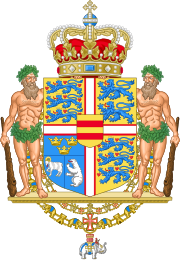
Back Primer ministro de Dinamarca AN رئيس وزرا دنمارك ARZ Министър-председател на Дания Bulgarian Primer Ministre de Dinamarca Catalan Předseda vlády Dánska Czech Danmarks statsminister Danish Ministerpräsident von Dänemark German Πρωθυπουργός της Δανίας Greek Ĉefministro de Danio Esperanto Primer ministro de Dinamarca Spanish
This article needs additional citations for verification. (June 2012) |
| Prime Minister of Denmark | |
|---|---|
| Danmarks statsminister | |
 | |
 | |
since 27 June 2019 | |
| Executive branch of the Danish Government Ministry of the State | |
| Style | His/her Excellency (diplomatic, outside Denmark[1]) |
| Member of | Council of State Cabinet European Council |
| Residence | Marienborg |
| Seat | Christiansborg, Copenhagen, Denmark |
| Appointer | The Monarch Based on Appointee's ability to gain majority support in the Folketing |
| Term length | No fixed term |
| Precursor | Privy Councillor |
| Formation | 22 March 1848 |
| First holder | Adam Wilhelm Moltke |
| Succession | by the 2nd highest ranking Privy counsellor |
| Deputy | Permanent secretary to the prime minister |
| Salary | 1,458,000 DKK (€195,900) annually[2] |
| Website | Official website |
 |
|---|
The prime minister of Denmark (Danish: Danmarks statsminister, Faroese: Forsætisráðharri, Greenlandic: Ministeriuneq) is the head of government in the Kingdom of Denmark comprising the three constituent countries: Denmark, Greenland and the Faroe Islands. Before the creation of the modern office, the kingdom did not initially have a head of government separate from its head of state, namely the monarch, in whom the executive authority was vested. The Constitution of 1849 established a constitutional monarchy by limiting the powers of the monarch and creating the office of premierminister. The inaugural holder of the office was Adam Wilhelm Moltke.
The prime minister presides over a cabinet that is formally appointed by the monarch. In practice, the appointment of the prime minister is determined by their support in the Folketing (the National Parliament). Since the beginning of the 20th century, no single party has held a majority in the Folketing so the prime minister must head a coalition of political parties, as well as their own party. Additionally, only four coalition governments since World War II have enjoyed a majority in the Folketing, so the coalitions (and the prime minister) must also gain loose support from other minor parties.
The current prime minister of Denmark is Mette Frederiksen, since 27 June 2019. Since 2022 her cabinet consists of the Social Democrats, Venstre, and the Moderates.
- ^ Protocol and Liaison Service Archived 27 September 2012 at the Wayback Machine, United Nations.
- ^ "Hvad tjener en minister?" [How much does a minister make?]. regeringen.dk (in Danish). Government of Denmark. 1 April 2022. Retrieved 7 May 2022.
